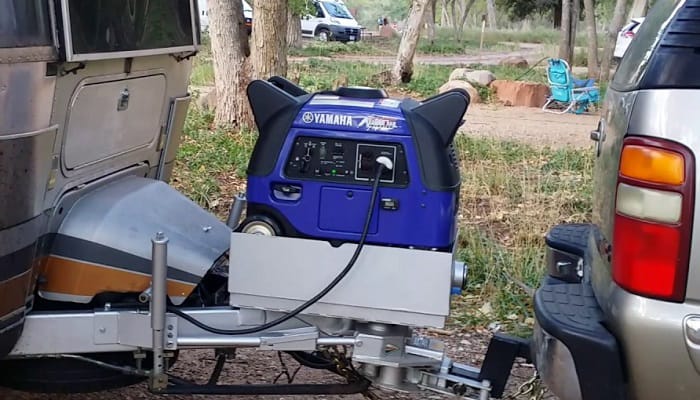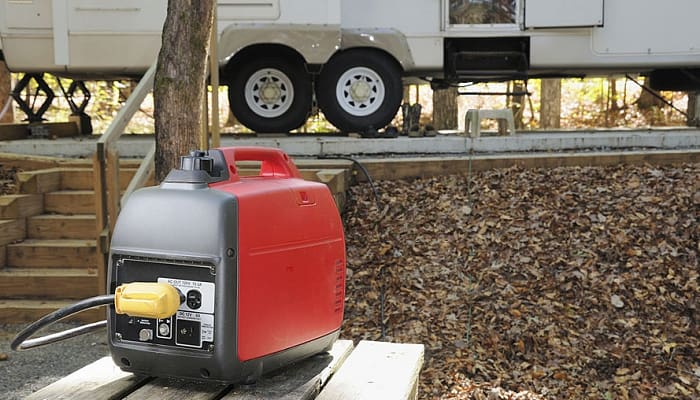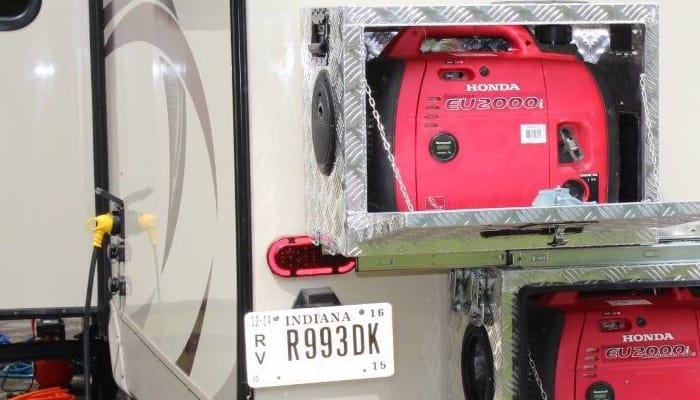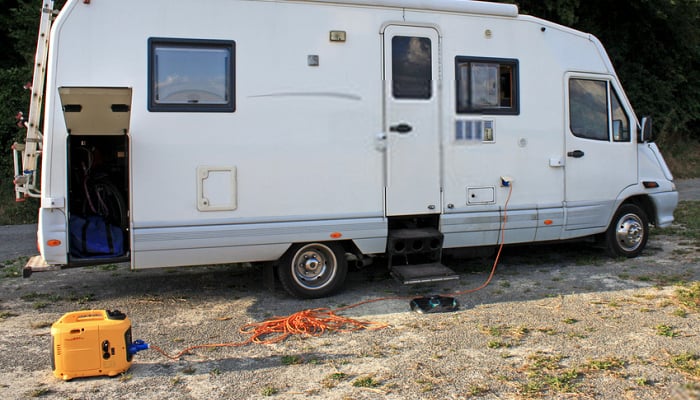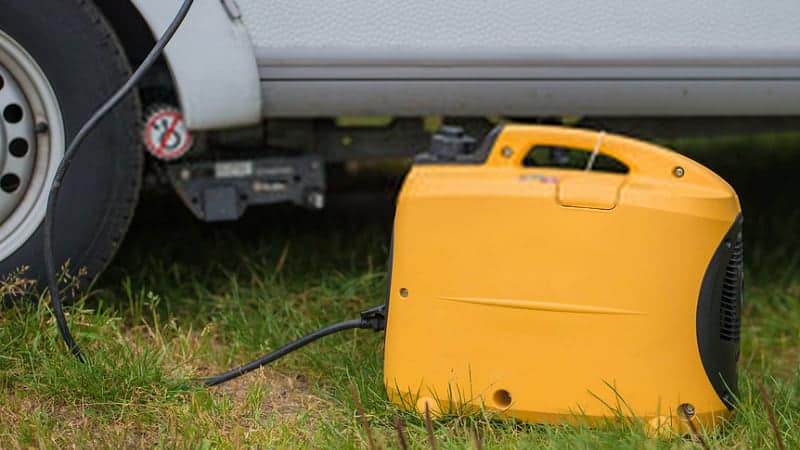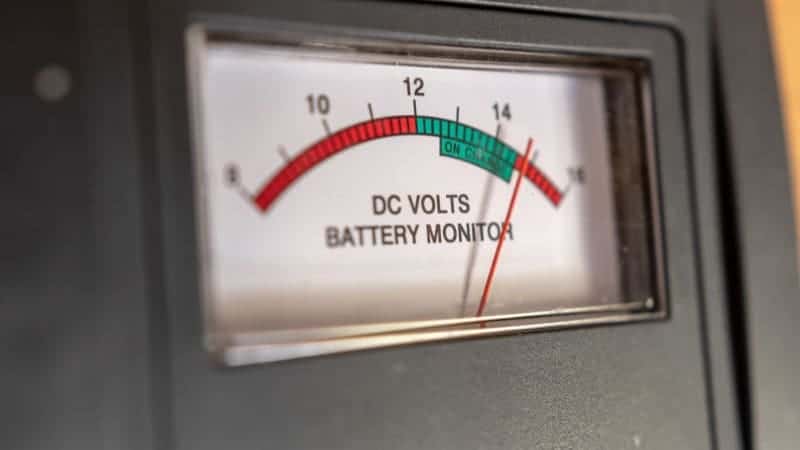How awful would it be when while you are in the middle of your camping trip, all of the lights in your RV suddenly went out? You suddenly have no power. Your refrigerator no longer runs and even your water pump no longer circulates water in your RV. Of course, this can be your chance to “rough it”
However, if you have your young kids with you, then it certainly will not do if you do not have at least some semblance of home in your RV. Things will look very different if you know how to charge RV batteries with a generator. Fortunately for you, this task is not that difficult at all.
It is a skill that you need to learn if you want to make sure that all of your RV trips will always be enjoyable. The usable lifetime of your RV batteries can be extended and its performance somewhat enhanced if you always charge it properly. Almost all RVs have an onboard generator and a 12-volt converter.
This means that you can use it to recharge the batteries used by the RV. Now, there are many different types of RV batteries and converters and almost all of them have their own ways of being recharged.
Table of Contents
Terms You Need to Learn
Before continuing with this guide, you need to familiarize yourself with the lingo used here. Taking the time to learn the technical terms will help streamline your learning process. The converter is a device that, as its name suggests, converts 120-volt power to 12-volts DC so it can be used by the RV batteries.
Converters are needed because the appliances and features of motorized vehicles are made to use 12 volts. If you use a converter, you can change the 120-volt power coming from the generator to 12-volts, which is the same output that the batteries have.
The generator can run on either gasoline, propane, or diesel. These generators can produce either 120 or 220 volts of power and when attached to a 12-volt converter, you can also use it to charge the house batteries.
Type of Battery Used
You must know the type of batteries used in your RV. The different types are the starting, marine, and 12-volt and 6-volt deep cycle batteries. If there is enough room in the RV and if they are wired correctly, there could be two batteries that are running the 12-volt electrical circuit in the RV.
The importance of determining the specific type of battery used in your RV stems from also learning what you will use to find out the correct recharging method and how many hours of charging it will take to get full use of the battery.
For instance, if you are the type who goes on long “unplugged” trips, two 6-volt, deep cycle batteries connected in series, will provide more than enough power. Another reason why you need to recharge your RV batteries properly is so they can last longer.
Most RV batteries have an estimated lifespan of around two years before they start to lose efficiency. However, with proper charging techniques, not only will your batteries last two years but they can also greatly exceed expectations.
2 Ways to Charge RV Batteries with a Generator
If you give your RV battery proper care and maintenance, it will greatly improve its recharging capacity and its usable lifespan. This means you no longer have to buy fresh batteries every year or so. Here are some tips on how you should care for your RV’s batteries:
- As much as possible, keep the batteries properly recharged.
- Avoid letting the charge of your batteries drop below 20% capacity. This will put unnecessary strain on your batteries when recharging.
- Keep a close eye on the electrolyte levels of the batteries and replenish the evaporated water with fresh distilled water every month or so.
- When topping up the battery’s water, fill it up only up to the vent cap.
- Only use distilled water as tap water contains minerals that will cause the battery to calcify.
The generator in your RV produces the same kind of electricity that your home uses, which is 120 volts. It also uses a converter to change its output to 12 volts, so that the onboard appliances can use it. Even though the generator can produce electricity, it is not meant for use as a battery charger.
If you have no other choice but to use the internal generator to recharge the house batteries, here is how you connect them properly:
Step 1 – Turn off all onboard appliances. Before you do anything, make sure that all of your onboard appliances are turned off and unplug anything that can potentially consume the RV battery’s charge. As much as possible, turn off all the lights to maximize the charging function of your generator.
Step 2 – Engage the emergency brake of your RV and put chocks on the wheels to prevent accidents. Afterward, check the terminals of the battery for any corrosion, and cracks and bulges in the body.
Step 3 – Using a wrench, slowly remove the cables connecting the batteries to the rest of the RV. You should remove the negative wire first (the black one) followed by the positive (red). Going the other way around will cause the cables to spark.
Step 4 – Clean the terminals to remove any dirt and debris. Use an old toothbrush and some baking soda with some water to scrub away all of the corrosion built up on the terminals. Dry them completely using a dry rag. If the corrosion is too thick, you need to use a wire brush and gently scrub away the corrosion.
Step 5 – Check the fluid levels of the batteries. If the water is getting kind of low, top it up using distilled water. Fill the battery only until the maximum point, nothing more.
Step 6 – Once the terminals are completely dry, reconnect the negative and positive wires on the battery. Tighten them just enough that you cannot move them using your hands. A good way to check is to move the battery a bit and check if the connectors move as well.
Step 7 – Plug your generator to an AC outlet via a converter and then turn on the generator. Generators cannot produce enough current to fully charge the RV battery. It can only charge the battery to about 80% to 90% and it will take a couple of hours to get at that level.
If you were to charge your batteries to 100%, it will take an entire day with the amount of electricity produced by the generator. You should just do that when you are back at home and when it is plugged into the municipal power grid.
Or
What You Will Need
- Portable generator
- Distilled water
- Wrench
- Baking soda
- Clean rag and toothbrush
- Battery rust protector or petroleum jelly
Step 1: Plug in the Generator
You first need to ensure that your generator is fully charged. Alternatively, you can plug it directly into an AC outlet. You should also turn off the RV and engage the emergency brakes in order to prevent accidents.
Step 2: Inspect the Battery
An inspection of your battery is very important so as to check for any signs of corrosion, cracks, and bulging. You need to clean the batteries if they have any fuzzy white, green, or yellow stains on them. If the battery and terminals are dirty, proceed to the next step. If not, proceed to step 6.
Step 3: Cleaning the Battery
Before you clean the battery, use a wrench to remove the cables. Start with the black or negative cable then the red or positive cable. After that, create a paste of baking soda and water then apply it to the battery terminals using a toothbrush. A wire brush will also help eliminate corrosion.
Once you have removed the grime, use a clean rag to wipe off the terminals until they are completely dry. Then, apply a battery rust protector or petroleum jelly to offer protection to the terminals against future corrosion.
Step 4: Check Electrolyte Levels
If your RV battery is not factory sealed, do check the electrolyte levels. If the fluids levels are low, slowly pour distilled water up to the fill point.
Step 5: Reconnect RV Battery
Reconnect the battery component, this time starting with the red (positive) cable followed by the black (negative) cable. Use a wrench to ensure that the cables are well fastened.
Step 6: Turn Off the Lights and Unplug Electrical Appliances
It is advisable to unplug all electrical appliances in order to maximize the charging of your RV battery. This is especially important if the generator is wired directly to the electrical system of your RV. It also helps to turn off the lights.
If possible, make sure that your generator is plugged into a 120V AC outlet. You can also use a portable generator with 12V C output; however, charging will be slow and the battery may not be charged to full capacity.
It is also paramount to know that the charging time can be affected by temperature. For instance, charging your RV battery at a temperature below 40 degrees may limit the charge capacity. For this reason, it is a good idea to park your RV or place the battery and generator where the ambient air temperature is above 40 degrees.
Step 7: Plug RV Plug into Generator
Once you have plugged in the generator to an AC outlet, connect it to the battery. If the conditions are ideal, charging may take around 2 to 4 hours. If the RV battery is depleted, it will take a longer time for it to get fully charged. Hence, I recommend not letting your RV battery to go below 20% as this can also lower its lifespan. Plug the generator into an outlet so you can use it later on.
Pro Tips
- Before you purchase your generator, see to it that you know the specifications of your battery. This is an important consideration because the power requirements of RV batteries may differ with amps, size, battery discharge level, and converter output level.
- Limit the use of electrical appliances if possible so as to save on power.
- Replace the RV batteries before they reach the expiration date.
- Clean your RV battery regularly.
- Don’t let your RV battery run down to less than 20%. Instead, ensure that it is charged at all times to prolong its longevity.
- Make sure you have a backup power source to help in times of emergencies, like when the generator runs down on energy.
Choosing the Right Portable Generator
If your RV does not already come equipped with an internal generator, you should buy a portable one that you can store in your RV and pull out whenever you need emergency electricity. It is also wise for you to pick a choice based on these crucial factors:
Fuel Tank Size – If you will be running the generator for hours on end, you need to have a generator that has a sizeable fuel tank. The capacity of the fuel tank will usually give you an idea of how long the generator can run.
For instance, a 5-gallon tank, which is quite substantial, can run for 7 hours on full capacity. You can double that time when you are just running it at half capacity. This is good to know if you will be using the generator to recharge the battery of the RV.
Noise Level – If you will be parking your RV in a public space, you need to choose a generator that does not produce a lot of noise. Find generators that produce noises that are below 70 decibels so that you can use it practically anywhere.
Weight – Since you will be carrying the generator with you in your RV, you need to make sure that it does not add too much weight to your RV. The thing here is that you have to balance the weight of the generator with its fuel capacity and electricity production. If your RV can handle the extra weight, get the generator with the largest fuel tank that you can fit in it.
Conclusion
Running out of battery power while you are in the middle of camping is no longer that hard to deal with. It is because fortunately, you can now recharge the battery using several different methods but the most efficient of all is using the RV generator.
However, because generators are not meant to be used as battery generators, charging the battery to 100% capacity will take a much longer time than if you would plug in your RV to the city electric grid.
Now that you know how to charge RV batteries with a generator the right way, you no longer have to dread if your battery gets drained while you are in the middle of your camping trip. You just need to prepare your batteries, hook up the generator to your RV and wait a couple of hours to get them running again.

Hi, I am Tom Hank, an RV-er since 2014. Back then, I started without much help. As you can imagine, the struggles are endless. But now, you do not have to begin your adventures knowing next to nothing about RV lives.


